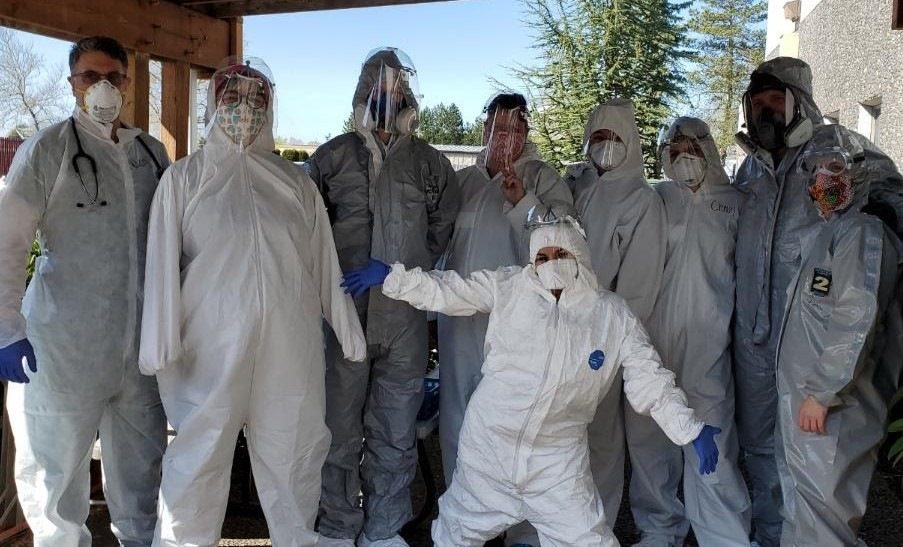Worldwide Sites
You have been detected as being from . Where applicable, you can see country-specific product information, offers, and pricing.
Keyboard ALT + g to toggle grid overlay
When the FIRST Robotics competition season was canceled due to the COVID-19 pandemic, Team 2471, based at Camas High School in Washington State, changed their challenge name from “Infinite Recharge” to “Infinite Resource” and quickly shifted gears to help out. Instead of building robots, team members joined forces with other teams in the Pacific Northwest, applying their technical skills to make PPE (personal protection equipment) for local healthcare workers on the front lines.
“I got involved because I really liked the idea of helping the people who are trying to help us—the people on the front lines who are risking the health of themselves and their families for the betterment of the community,” says Ayla Crowell, who’ll attend Camas High School in the fall as a freshman.
To date, the teams have manufactured more than 12,000 eye shields and 7,000 face shields and distributed them to nearly 100 health care organizations throughout Washington and Oregon, including Kaiser Permanente, PeaceHealth, Legacy Emanuel, OHSU, and more.
Team 2471 mentor Bruce Whitefield is impressed, but not surprised, that students who had to deal with the disappointment of canceled robotics competitions rose to the challenge of supporting health care workers. “The students voted to spend the money they would have used for the robotics competition on PPE materials instead—and then raised another $20,000 through GoFundMe,” says Whitefield. His older daughter, who’s completing her PhD in clinical biology and infectious diseases, warned him early on that local hospitals would likely run out of PPE, giving the students a jumpstart on purchasing supplies.
The teams shared and swapped equipment and got to work. “We got about a dozen 3D printers out of schools and put them into students’ homes,” Whitefield says. Instructors also got permission to use a high school laser cutter to cut plastic for face shields; a hand-cranked lens-cutter machine was traded among several students’ homes to cut eye shield lenses.
“This project inspired more than just the team, it inspired the whole community,” adds Whitefield. “Whether it was donating to the GoFundMe or saying, ‘What can I do to help, can I machine something for you, can I make an injection mold, can I get materials , can I print stuff?’—it was literally hundreds of people and multiple organizations and companies that came together, just looking for a way to help.”
“It’s cool to think that even as a small team, we were able to go out and coordinate this amazing project,” says Justine Pendergraft, a junior at Camas High School. “I’m surprised at how we all came together and did something cool. These opportunities to help a lot of people don’t come along that often, so once they do, you just seize them.”
In keeping with the “Star Wars” theme for the canceled “Infinite Recharge” robotics competition, the students gave their face shields “Star Wars”-inspired names. The “Mandalorian” face shields were designed for comfort, while the “Stormtroopers” frameless face shields have wraparound protection for health care workers in direct contact with coronavirus patients.
Team members chose to make face and eye shields without foam or elastic, so the PPE could be sanitized and reused. Using Autodesk Inventor, they iterated and improved on their designs after getting early feedback from health care professionals. Once the design was finalized, Gabriel Guo, a junior at Camas High School who runs the Team 2471 website, posted the files online so other robotics teams could join the project and help make a difference.
“Our robotics organization always says that it’s about more than just robotics,” Guo says. “This project is a great example of how we can use the skills that we learned from our generous mentors—who donate their time—for doing something good, such as making face shields for those on the front lines. It just feels good that at this age, we can already start to give back with the skills that we’ve learned."
Ways to Contribute to
Combatting COVID-19
Our goal is to connect resources and people looking to help with pressing needs. If you have projects or resources that could help communities with COVID-19 efforts, please take the next step.


